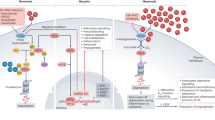Abstract—The goal of the present study was to investigate the molecular mechanisms that underlie heart and skeletal muscle damage in male Wistar rats weighing 200–250 g in response to a 3-h exposure to 180 mm Hg (5% O2) in the model of severe hypobaric hypoxia. It has been demonstrated that the level of the cardiac biomarker troponin I in the blood plasma of rats exposed to severe hypobaric hypoxia for 3 h increased significantly compared to the control group, indicating myocardial injury. At the same time, the administration of the HIF-1α transcription factor inhibitor did not affect the plasma level of troponin I. In contrast, the release of the non-specific biomarker myoglobin into the bloodstream did not increase in response to hypoxia compared to the control animals. In addition, 24 h after the exposure to severe hypobaric hypoxia the serum myoglobin level was significantly lower in animals administered with the HIF-1α inhibitor topotecan than in rats that did not receive topotecan. Therefore, it may be assumed that the inhibition of the HIF-1α transcription factor 10 min before exposure to severe hypobaric hypoxia reduces skeletal muscle damage. The mechanisms that affect the adaptation of heart and skeletal muscles to hypoxia are discussed.


Similar content being viewed by others
REFERENCES
E. Rybnikova and M. Samoilov, Front. Neurosci. 23 (9), 388 (2015).
W. Kaelin and P. Rateliffe, Mol. Cell. 30, 393 (2008)
Y. Sun, X. Chen, et al., Front. Mol. Neurosci. 10, 257 (2017).
O. V. Vetrovoy, Extended Abstract of Candidate’s Dissertation in Biology (St. Petersburg, 2018) [In Russian].
W. Kaelin, Ann. Rev. Biochem. 74, 115 (2005).
K. Janke, U. Brockmeier, et al., J. Cell Sci. 126 (12), 2629 (2013).
E. Rybnikova, N. Sitnik, et al., Brain Res. 1089 (1), 195 (2006).
H. Ban, Y. Uto, and H. Nakamura, Expert Opin. Ther. Pat. 21, 131 (2011).
O. V. Vetrovoy, Candidate’s Dissertation in Biology (St. Petersburg, 2018) [In Russian].
N. A. Plokhinskiy, in Current Problems in Modern Genetics, Ed. by S. I. Alikhanyan (Moscow State Univ., Moscow, 1966), pp. 564–602 [in Russian].
J. K. Brunelli, E. Bell, et al., Cell Metab. 1, 409 (2005).
K. Mansfield, R. Gury, et al., Cell Metab. 1, 393 (2005).
R. Hagen, C. Taylor, et al., Science 302, 1975 (2003).
R. Dangel, O. Bernardette, et al., Sci. Rep. 7 (12092), 1 (2017)
M. Feelisch, C. Pensenstadler, et al., J. Biol. Chem. 283, 33927 (2008).
N. V. Kuleva and I. E. Krasovskaya, Tsitologiya 57 (8): 563 (2015).
N. V. Kuleva, D. A. Fedorov, and I. E. Krasovskaya, Tsitologiya 60 (1), 5 (2018).
N. V. Kuleva and I. E. Krasovskaya, Biophysics (Moscow) 61 (5), 717 (2016).
T. Clanton, J. Appl. Physiol. 102, 2379 (2007).
T. Chaillou, Front. Physiol. 9 (1450), 1 (2018).
ACKNOWLEDGMENTS
The authors are grateful to Dc. O.V. Vetrovoy for organizing the experiments on animal model of severe hypobaric hypoxia.
Author information
Authors and Affiliations
Corresponding author
Ethics declarations
All the international, national, and institutional guides for the care and use of laboratory animals were followed.
Additional information
Translated by I. Matiulko
Abbreviations: HIF, hypoxia-inducible factor; NO, nitrogen monoxide.
Rights and permissions
About this article
Cite this article
Fedorov, D.A., Frolova, M.Y., Krasovskaya, I.E. et al. The Effects of Severe Hypobaric Hypoxia and Inhibition of Hypoxia-Inducible Factor-1 (HIF-1) on Biomarkers of Cardiac and Skeletal Muscle Injury in Rats. BIOPHYSICS 64, 808–811 (2019). https://doi.org/10.1134/S000635091905004X
Received:
Revised:
Accepted:
Published:
Issue Date:
DOI: https://doi.org/10.1134/S000635091905004X




